North Fork Bob - 2011
'09 maps for:
Bea
--
Buck -- Caley --
Claws --
Conomo --
Hix --
Hudson 09 -- Isabel --
Katy -- L.R. --
Moffet --
Mr. Hannah --
Ozzie --
Penelope
--
Rafael
2010 maps for: Belle
-- Buck --
Gunny --
Hudson --
Mr. Hannah --
Neale --
North Fork Bob
--
Penelope --
Sanford
-- Sr. Bones --
Thatch
2011 maps:
Belle --
Buck --
Henrietta --
Katbird
-- North Fork Bob --
Pemi --
Saco --
Sanford --
Sr. Bones --
Snowy --
Thatch -- Tucker
2012 maps: Art --
Belle --
Bridger --
Chip --
Cutch --
Jill -- North Fork Bob --
Rammie --
Snowy --
Sr. Bones -- Thatch
2013 maps: Art --
Belle --
Bridger --
North Fork Bob --
Rammie --
Snowy --
Sr. Bones
Osprey
main page --
Migration
page --
Migration09 --
Migration10 --
Migration 11 --
Migration 12 --
Migration 13 -- Home
Page
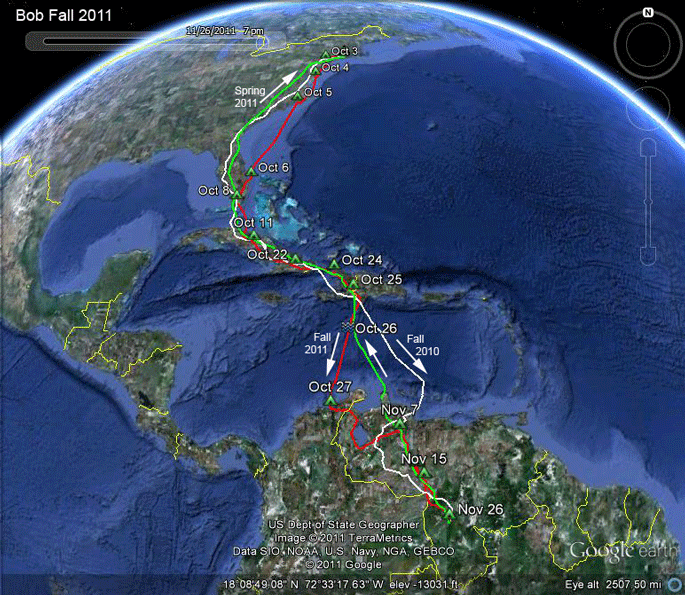 |
3 Dec 2011: North Fork Bob returned back, safe
and sound at his winter home in the highlands of
the Guianan Shield in southern Venezuela and
then turned around and moved back north. This is a typical route for an adult. When the wind is out of the west, they tend to go down the east coast to the Outer Banks of North Carolina. From there, they head out over the Georgia Bight for a roughly 500 mi. trip to Florida. After a day in the Everglades, Bob moved on to Cuba, where he spent a week making us very nervous by hanging around a fish farm. He's since moved on and is now safely across the Caribbean in Colombia. He hit the coast 350 mi (560 km) west of where he did last year and worked his way east and then south towards home. He made one aborted trip up into the highlands. Best guess is that he ran into bad weather at high elevations. He retreated 193 mi (310 km) to a good fishing spot. After another week or so there, he took 5 days to get home. Scroll down for all his movement this year, or... Skip to the start of fall migration. |
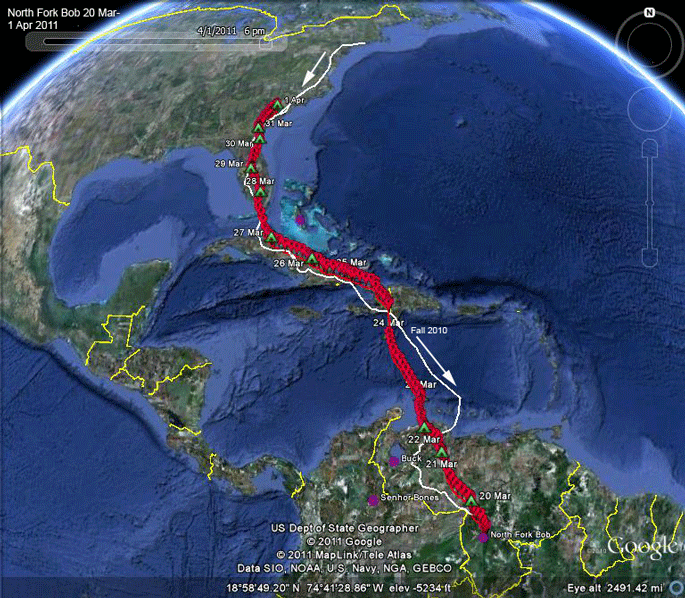 |
Spring Migration:
20 Mar-1 Apr 2011:
North Fork Bob is most of
the way home, probably about 4 days left, if the
weather holds for him the whole way. (Haven't added new detailed maps yet--coming soon) |
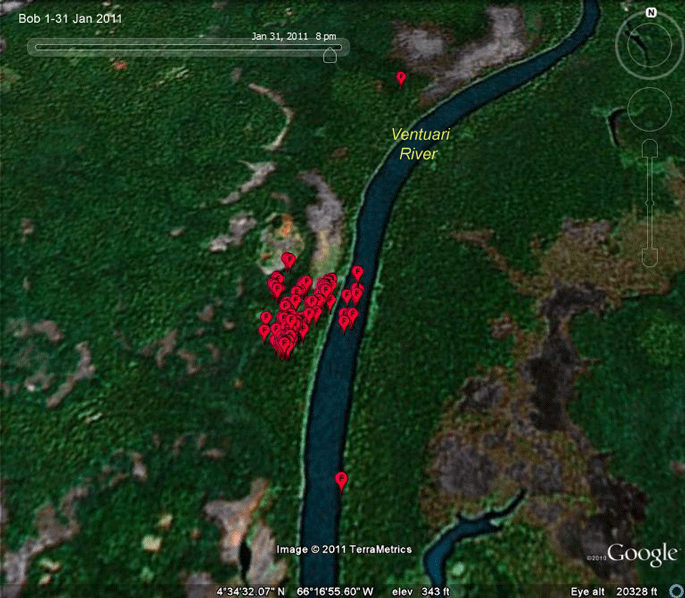 |
1-31 Jan 2011. Bob has obviously landed in a very fishy spot. Most of the points on this map are no more than a kilometer (0.6 miles) apart! That is is tightest cluster of satellite fixes I've ever seen. Tongue fully in beak, I wonder how he's getting enough exercise to be ready for the trip north, which should begin in the next 3 weeks or so. |
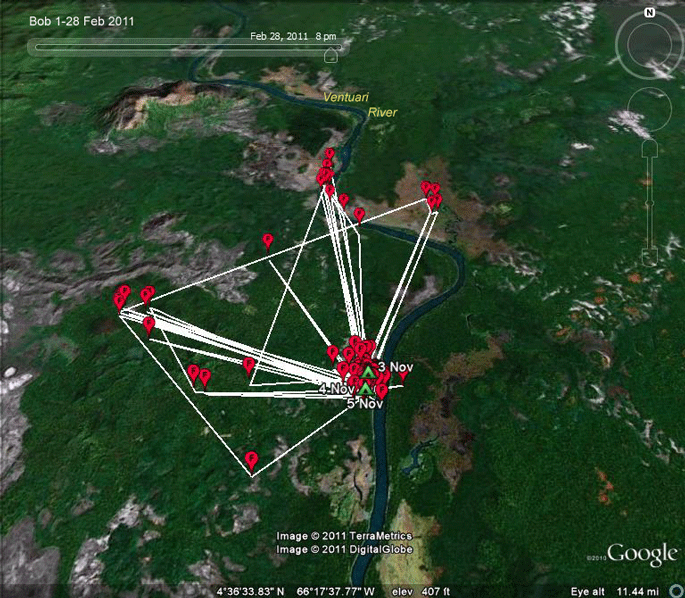 |
1-28 Feb 2011. Bob has been fishing a bit farther from his winter headquarters this month, going as far as 7 miles (11 km). This is a bit more typical of a wintering adult. The tiny cluster of points marking his satellite fixes over the past couple of months was unusual. |
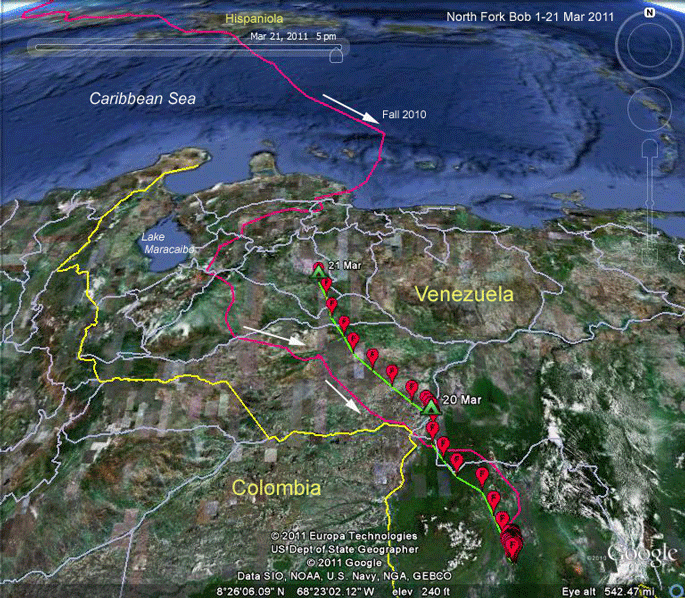 |
1-21 Mar 2011. Bob is finally heading home. He's off to a late start--the first birds started arriving in southern New England last week. He's off to a good start--350 mi (560 km) in the first two days. Assuming he follows the usual route through Hispaniola, Cuba, and then up the east coast, he has about 2,740 mi (4,410 km) to go. In theory, with ideal conditions, he could make it in two weeks. |
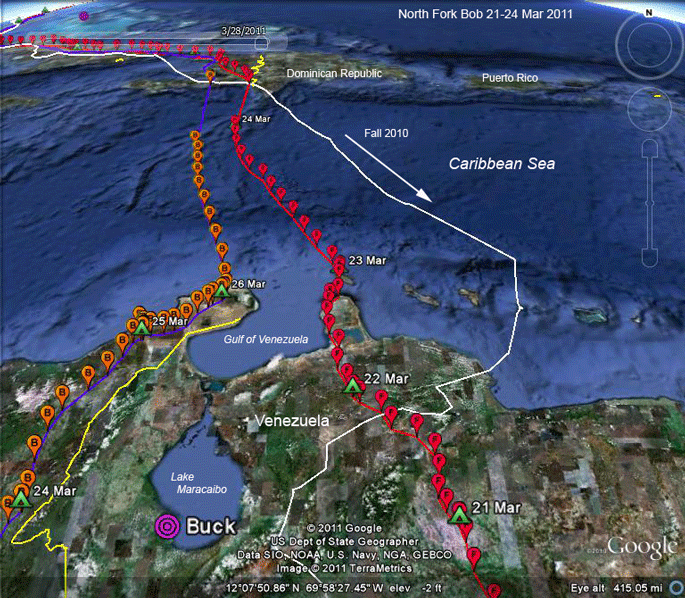 |
21-24 Mar 2011. The tracks of both Bob (red) and Sr. Bones (orange) provide great confirmation of the generalization that Ospreys use a couple of simple "rules" in picking their migration routes--in the spring, head more or less north and stay over land as long as possible. This simple migration algorithm got Sr. Bones to the Guajira Peninsula (the northernmost point of land in the continent) and Bob to the next northernmost point of land across the Gulf of Venezuela. |
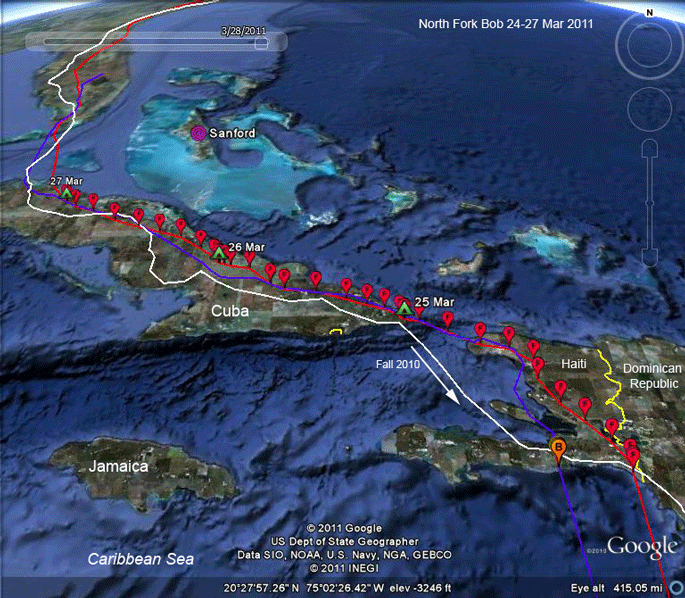 |
24-27 Mar 2011. Bob is a bird on a mission. He spent less than 24 hours in Haiti and then pushed on through Cuba in just over 2 days. Also on this map are Bob's fall trip south and, in purple, Sr. Bones' track this spring. There's a bit of randomness to trips in both directions, but often geographical features (rivers, coastlines, mountains) will funnel birds along similar paths. I'm going to check with my Cuban colleague, Freddy Santana, to see if there's a reason that Bob and Bones took the same route through northeastern Cuba. |
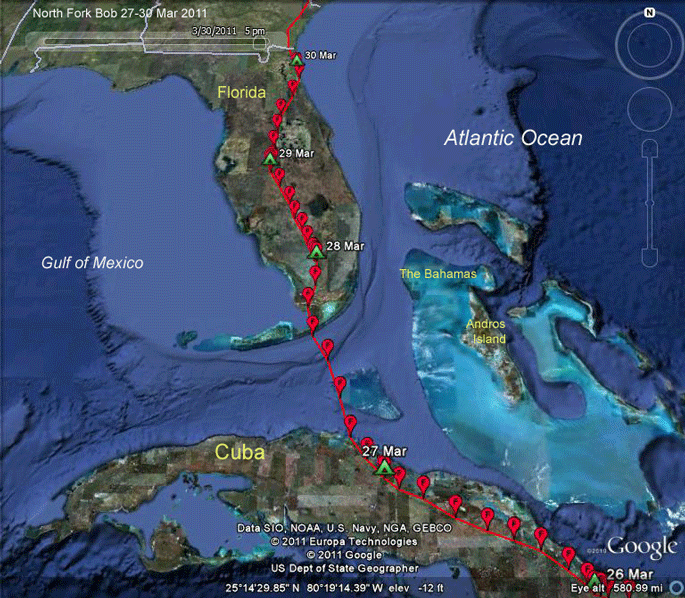 |
27-30 Mar 2011. Always good to see our birds
make it through Cuba without stopping at a fish
farm! Bob took care of Florida in just a couple of days. |
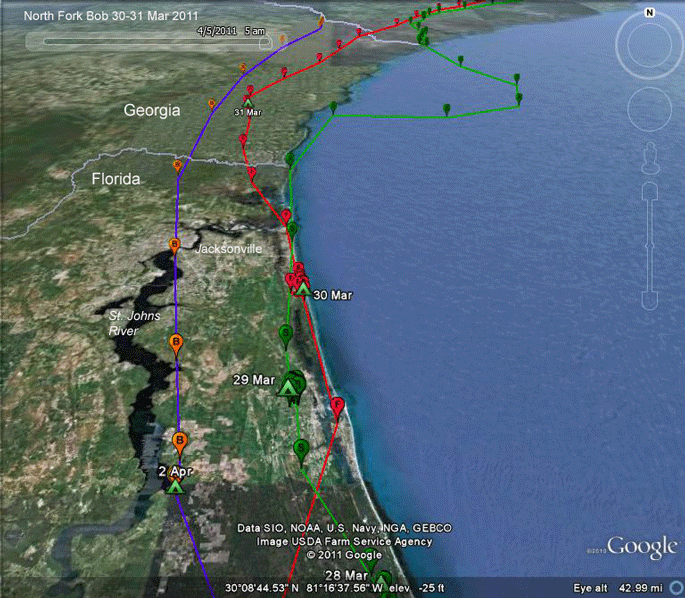 |
30-31 Mar 2011. Bob found his way to the
Florida coast in the afternoon of the 30th and
roosted southeast of Jacksonville. The tracks of Sanford (green) and Sr. Bones (orange) show that all three of our adults came through this area in a five-day period. This would be a good place to watch Ospreys during both the spring and fall migrations. The St. Johns River is a particularly favorite stopover for birds heading south in the fall. |
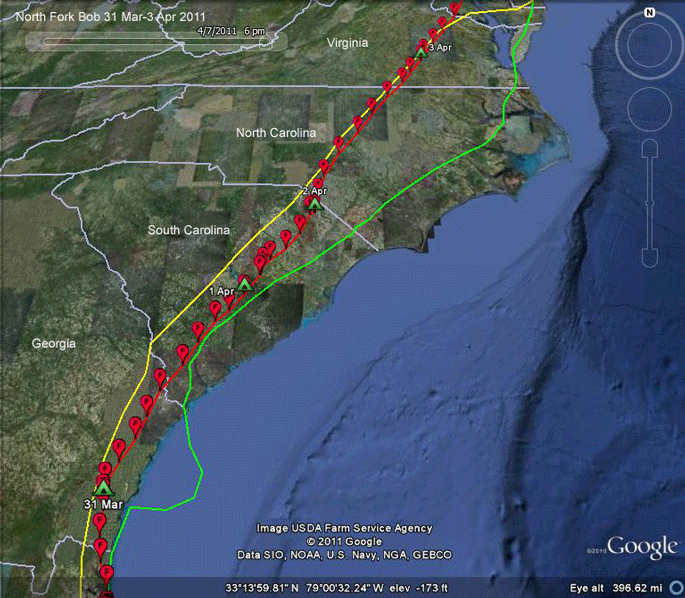 |
31 Mar-3 Apr 2011. Bob's on a beeline for
home. Yellow track is Sr. Bones heading to
Nantucket and Sanford heading to the Westport
River. Clear sailing this week. |
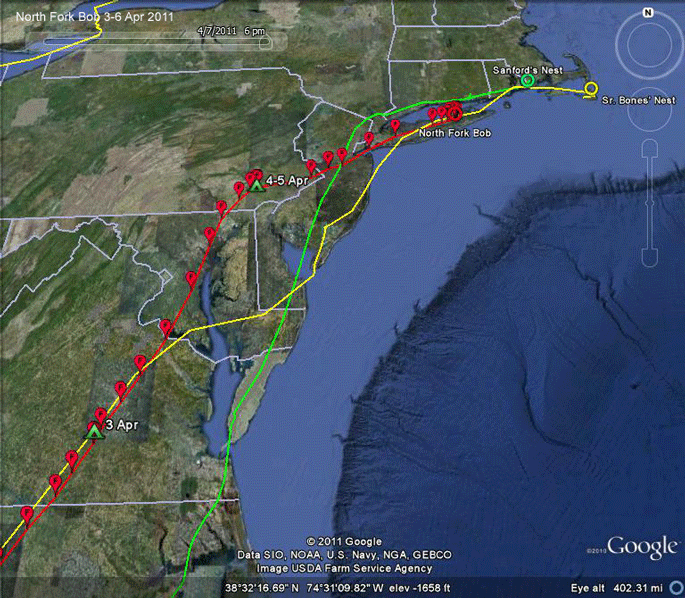 |
3-6 Apr 2011. Bob arrived on Long Island's North Fork around 2PM on April 6th. Unlike his fellow travelers, he went inland of the two bays (Chesapeake and Delaware). He got stuck in a really nasty storm on the 5th and waited it out. (see below!) |
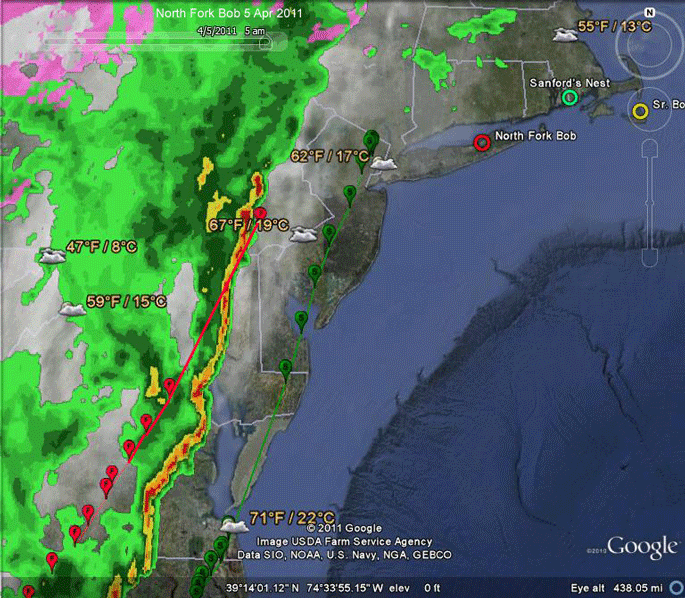 |
5 Apr 2011. A remarkable weather front moved across the whole east coast on the evening of 4 April. Bob hunkered down for the day on a small pond at a golf course near Coatesville, PA, northwest of Philly. |
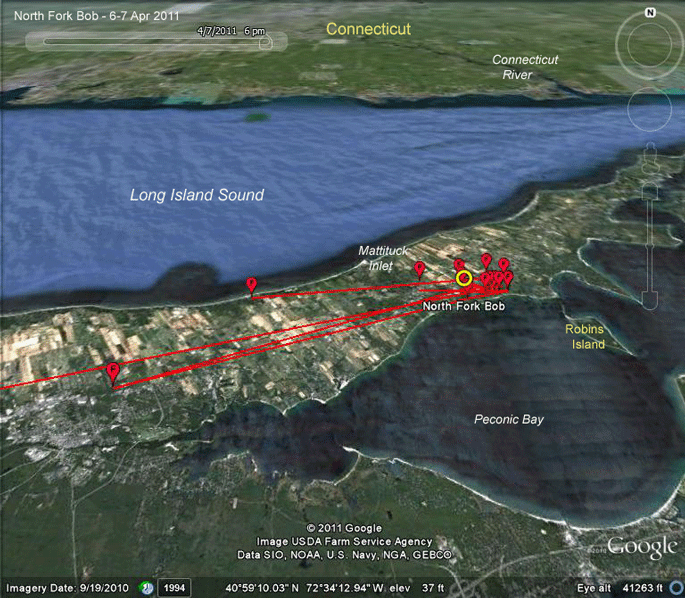 |
6 Apr 2011. Bob is home! It took him 18 days to make the 3,100 mi (5,050 km) trip. |
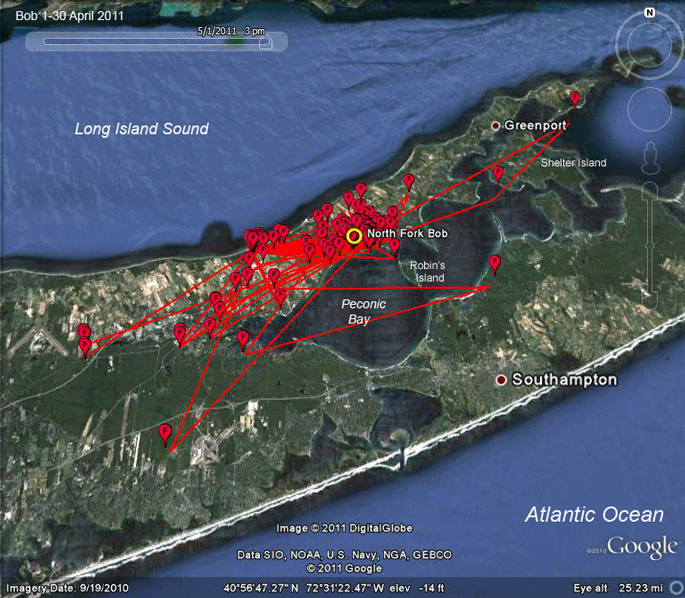 |
1-30 Apr 2011.
Bob did not nest this year. He got back a bit
late, and because we don't have anyone on the
ground to watch the nest, we can't be sure what
happened. It might be that his mate did not
return from her migration (it was a really bad
fall to cross the Caribbean, as we discovered
only too painfully) and there wasn't an
available young female to fill the slot. So this summer's data will show us the travels of an Osprey footloose and fancy free. Just biding time really, until the next migration season, and on the other side of that, another chance to breed. |
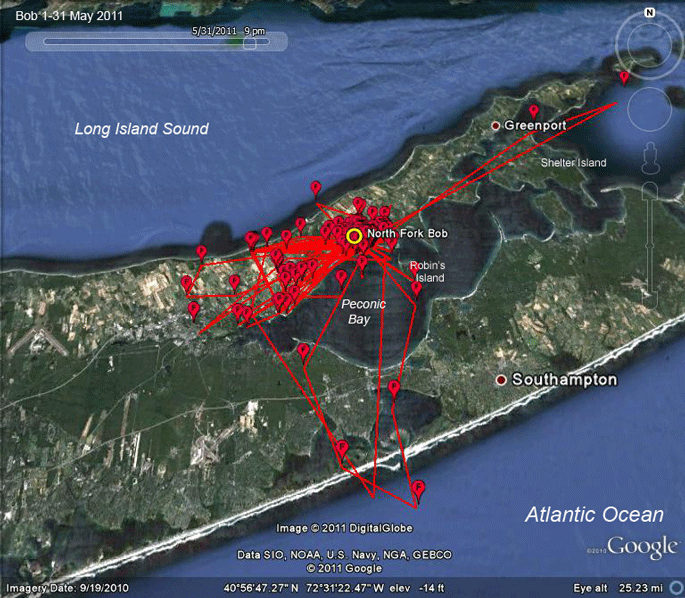 |
1-31 May 2011. Bob made a couple of trips away from his usual neighborhood. He went out over the Atlantic on May 2nd and again on the 3rd of June (that track shows up here but not the location marker). |
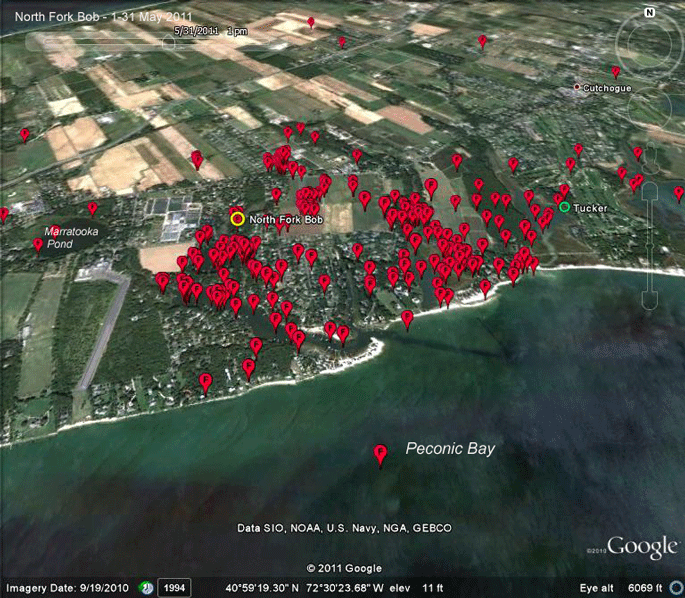 |
1-31 May 2011. A closer look at his locations close to home during May. |
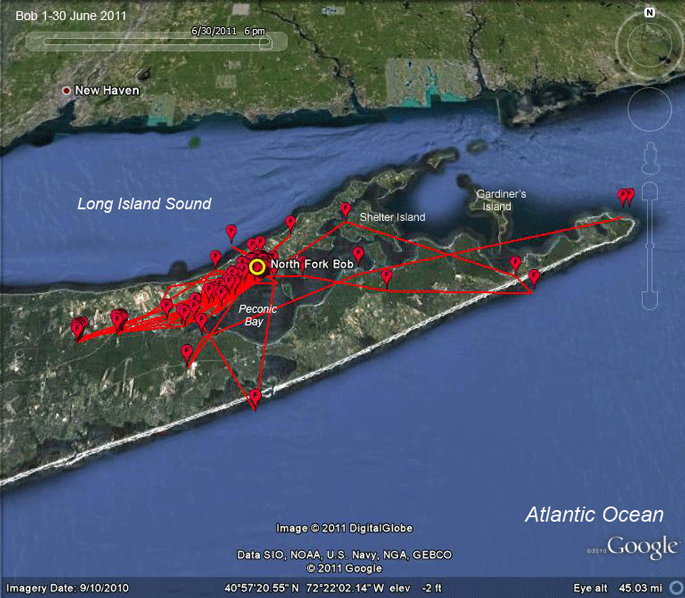 |
1-30 June 2011. More of the same here, really, with a couple of trips away from his usual area. The two clusters of locations west of home are a couple of ponds at the Swan Lakes Golf Course near the Calverton air field. |
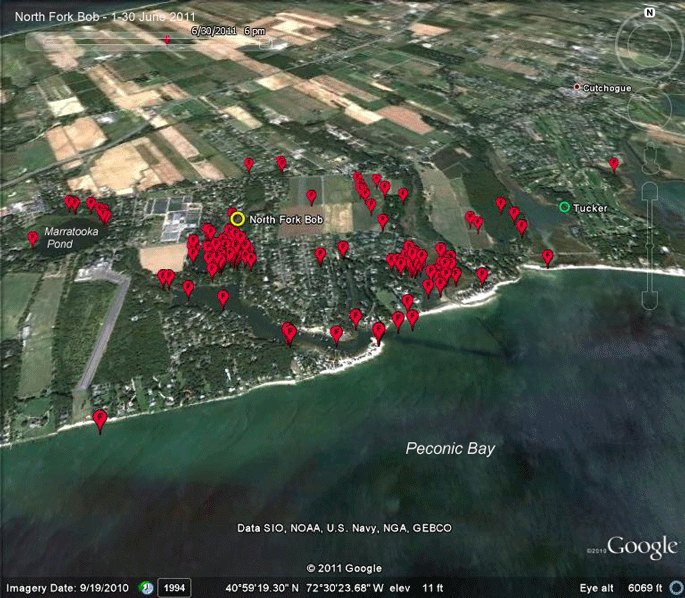 |
1-30 June 2011. Locations around the (unused) nest in June. |
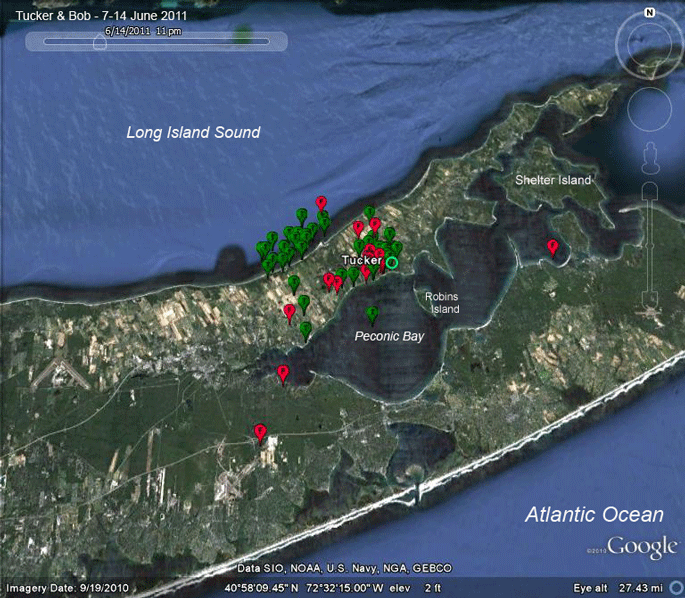 |
7-14 June 2011. Here's a comparison of Tucker and Bob's foraging during the second week in June. Tucker spent a lot of time foraging out in Long Island Sound. (More comparisons of the two are on Tucker's map page.) |
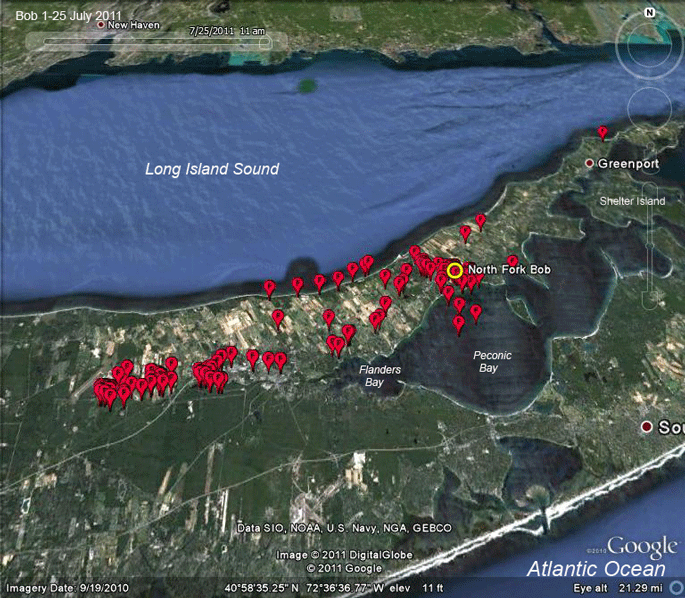 |
1-25 July 2011. Bob stayed a little closer to home in July. Looks like he was doing some fishing in the sound, but not as much as his late neighbor Tucker did. At least he didn't range as far off shore. |
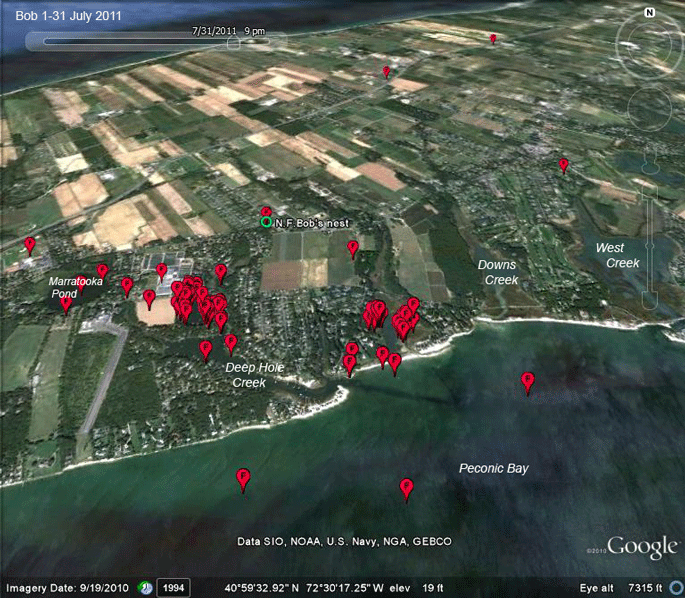 |
1-31 July 2011. The action close to home. Same old same old. |
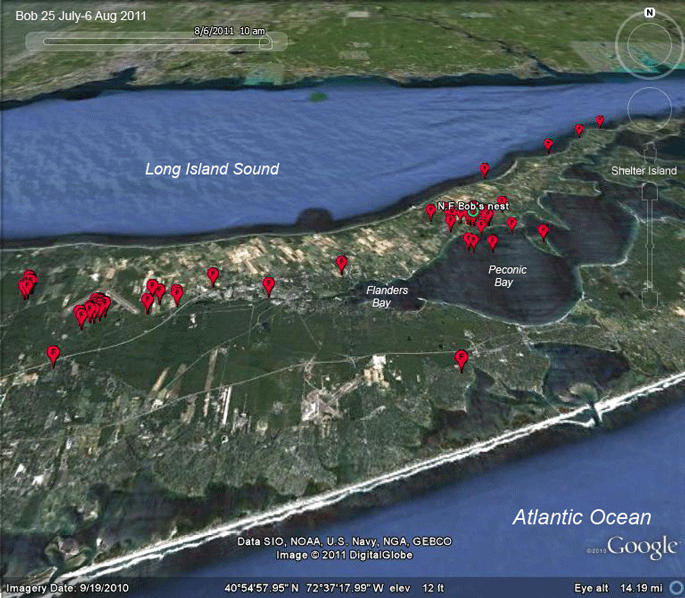 |
25 July - 6 Aug 2011. A bit more time spent working up the North Fork north of Shelter Island. Still likes the Swan Lake Golf Course ponds west of Flanders Bay. I've left the tracks connecting points out of this map. With the tracks included, the area between Bob's nest and the western most locations is pretty much painted red. This means that almost all the points to the west are a single visit with a return to his home base. One might misinterpret this map as indicating that he flew out to the west and spent long periods of time there before returning to the nest. |
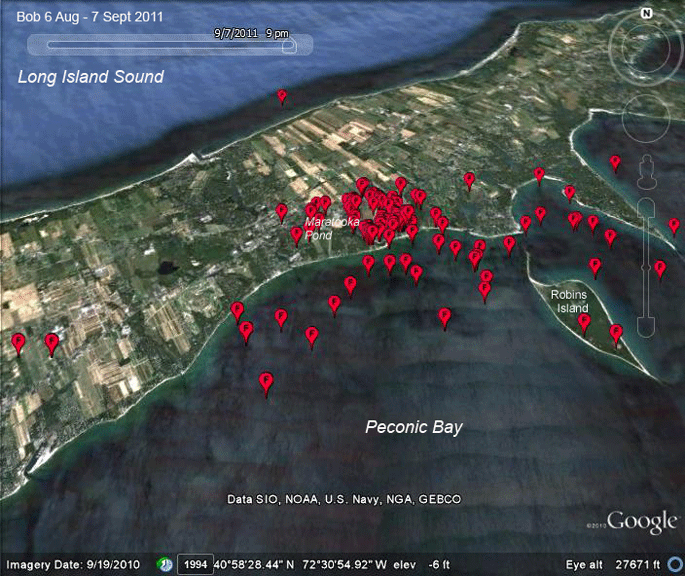 |
6 Aug - 7 Sep 2011. A very interesting shift here. Obviously, some fish species has appeared in Peconic Bay. The fishing has been so good, that he has completely focused his activity in this small area around the nest. The next map compares July and August foraging areas. |
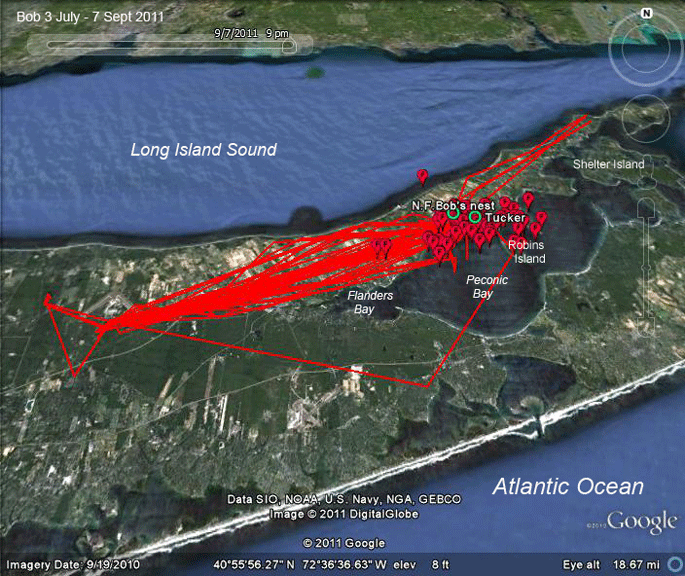 |
3 July - 7 Sep 2011. A fascinating shift here. The red lines without location flags record Bob's movements from early July through the 4th of August. From then on, Bob apparently found the fishing so good in Peconic Bay that he no longer needed to commute. Everything he needed was right there in his front yard. |
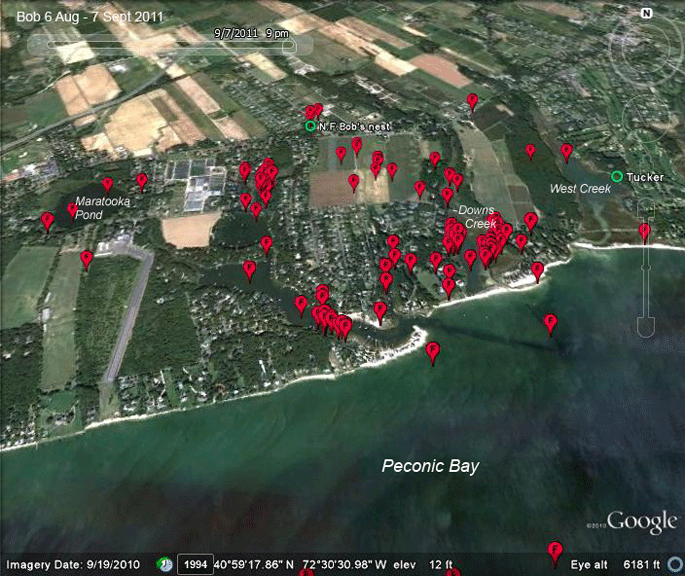 |
6 Aug-7 Sep 2011. Close to the nest, the big change here is that he's not spending so much time around the pond just east of Maratooka Pond (Deep Hole?). |
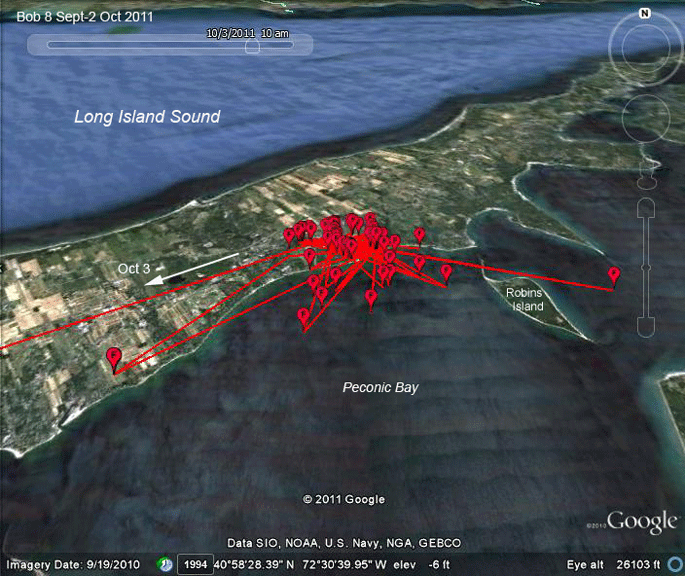 |
8 Sept-2 Oct 2011. Still hunting a lot in Peconic Bay for most of September. He took off for points south around 9 AM on Oct. 3rd. |
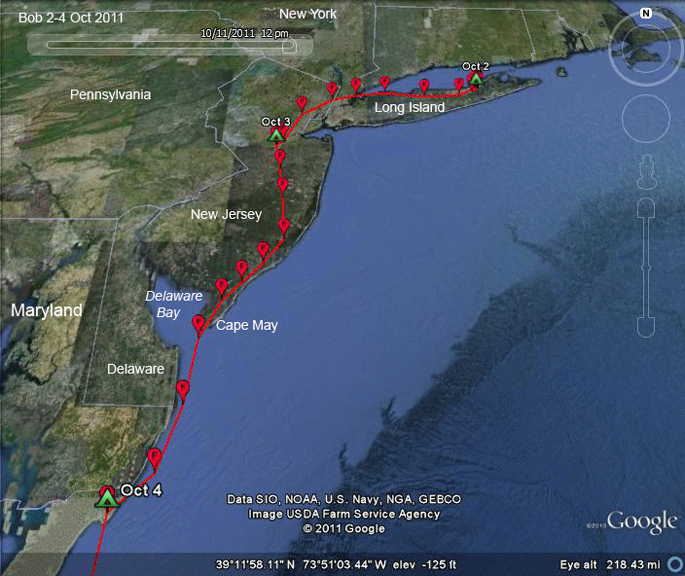 |
3-4 Oct 2011. Bob left Mattituck around 9 AM on the 3rd and spent the night of at a little pond near South Brunswick, NJ. On the 4th, he was probably counted by the hawk watchers at Cape May. He spent the night of the 4th on Chincoteague Island in northern Maryland. Looks like he skipped Delaware this year! |
 |
5 Oct 2011. Bob got a very early start to the day's migration, heading out over open water from Chincoteague Island around 6AM. He hit the Outer Banks in North Carolina around 10AM and probably did some fishing there before pushing on to Cape Lookout, where he spent the night of the 5th. |
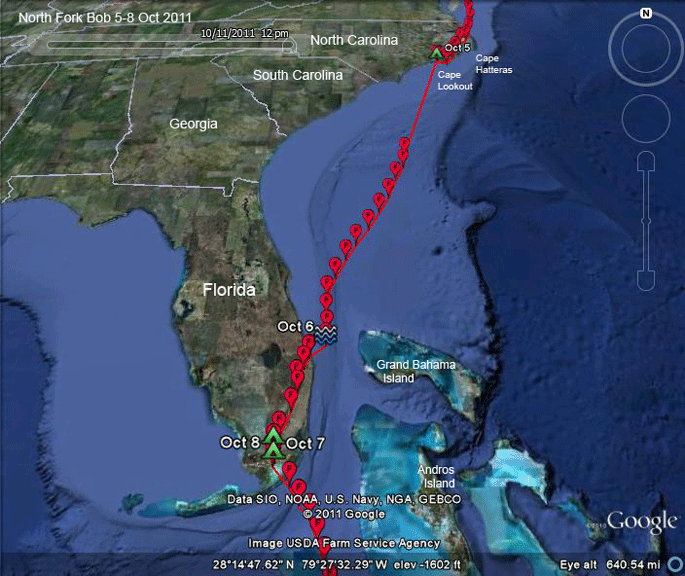 |
5-8 Oct 2011. Bob took off from the Cape Lookout area around midnight on the 5th. This is really unusual. We've had lots of birds migrate at night, but that was always after taking off during the day and getting stuck out over the water when the sun went down. I can't imagine why Bob took off in the middle of the night. The last fix of the day was at 8PM (the blue wavy lines) on Oct 6. It would have been dark by then, but he had only a short way to go before getting to the Florida coast. He hung around Jupiter (just north of Palm Beach) until 10AM and then was off to the Everglades and Florida Bay. |
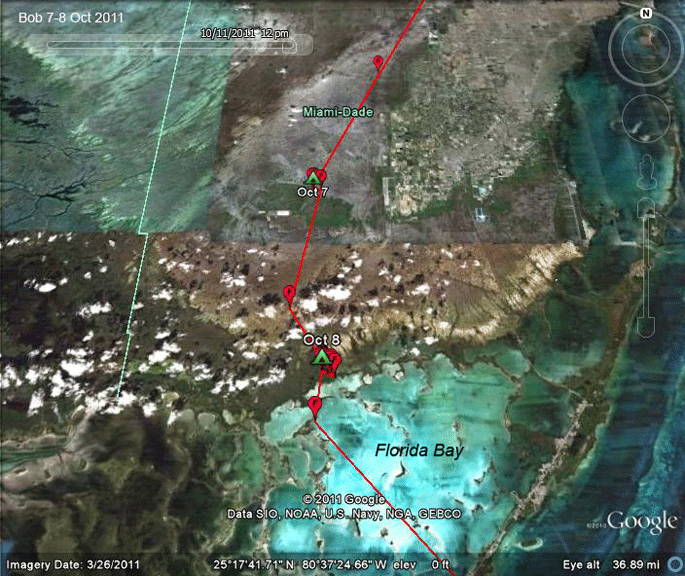 |
7-8 Oct 2011. Bob spent the 8th around the Everglades and the north shore of Florida Bay. |
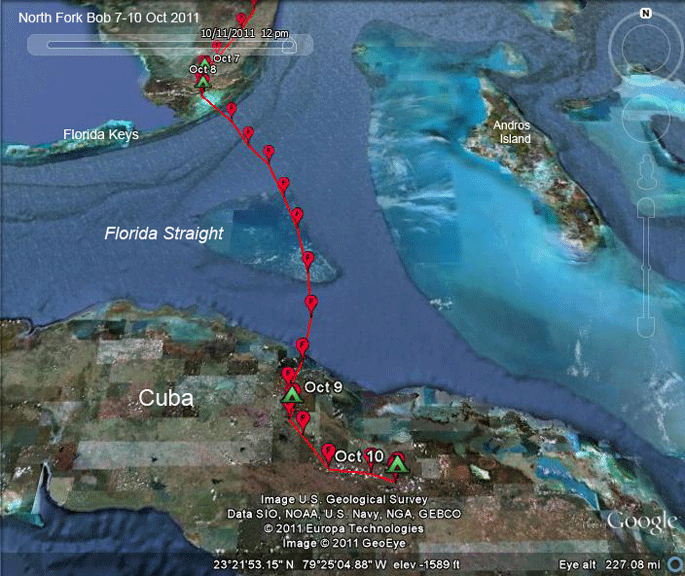 |
7-10 Oct 2011. After a day around Florida
Bay, Bob took off for Cuba around 9 AM on the
9th and about 8 hours later arrived on Cuba's
north shore. On the 10th, migration consisted of about 3 hours' movement southeast to the vicinity of the tiny village of Venegas. |
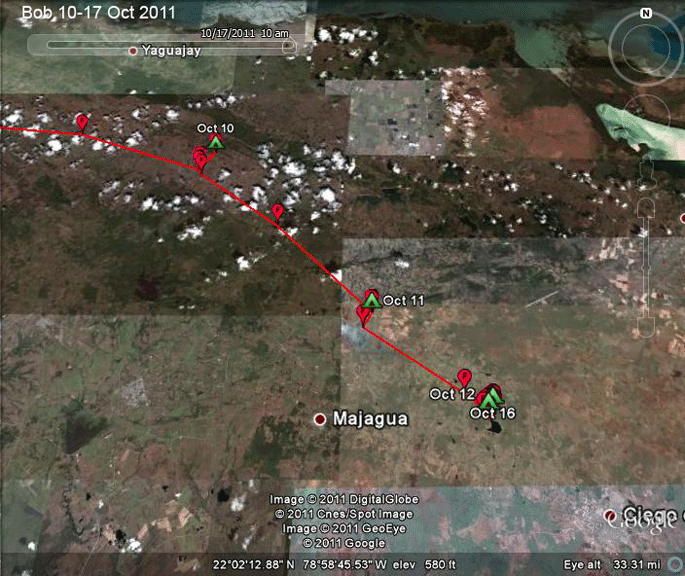 |
10-17 Oct 2011. Bob continued his "migration lite" movement through Cuba. On the 12th he found a small reservoir has an associated fish farm, which is making us very nervous! We've lost too many Ospreys in Cuba at just this kind of location to feel good about this. |
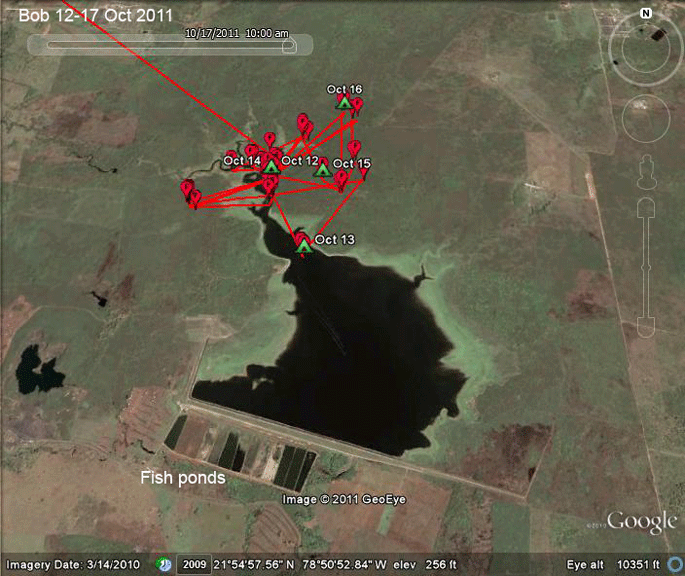 |
12-17 Oct 2011. Bob has settled down at this
small reservoir. Fortunately, for the past 6
days it seems Bob has found all that he needs up
in the stream that feeds the reservoir and
hasn't been dipping his talons into the fish
ponds. Because we only get fixes every hour, we
can't be sure that he hasn't been down to the
ponds, but chances are had he been down there,
we'd have at least one fix near the ponds. I'll be very happy when he moves on from this spot. |
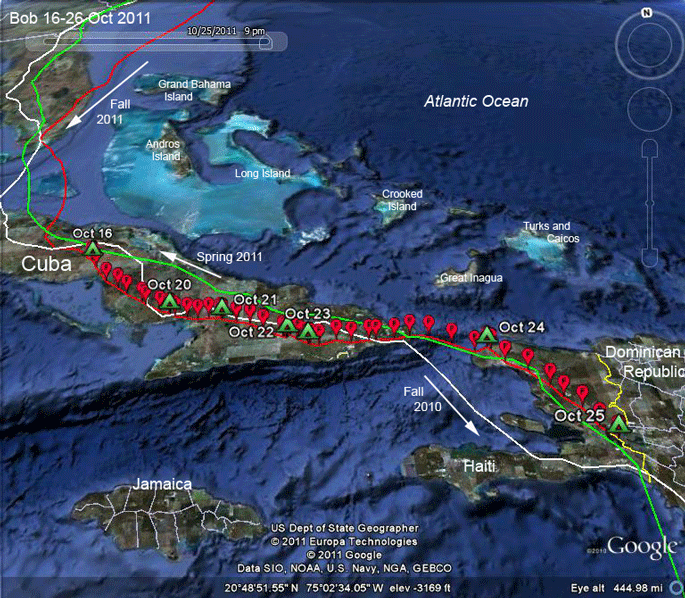 |
18-26 Oct 2011. Bob survived his stay near a fish farm and started moving again on the 20th. He kept moving at a modest pace through Cuba and over to Haiti on the 24th. |
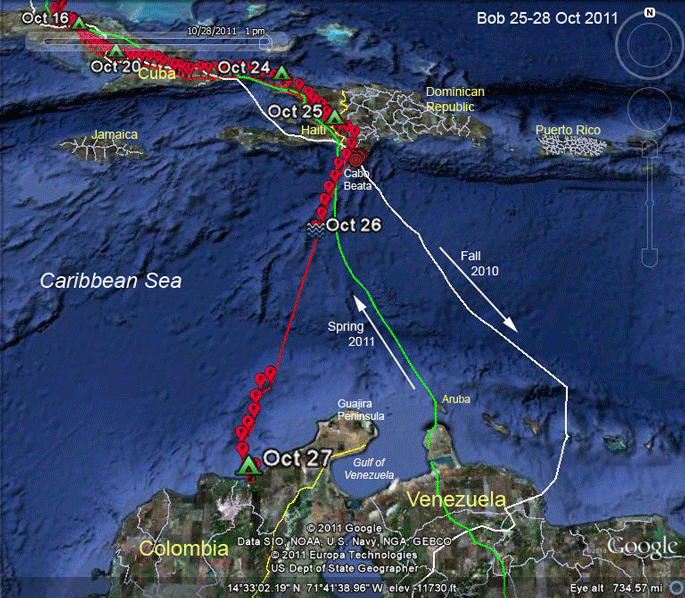 |
26-27 Oct 2011. Bob kept right on going and
crossed the Caribbean in 25.5 hours. During that
time, he covered 472 miles (760 km) at an
average speed of 19 mph (30 kph), which suggests
he was probably fighting a bit of a headwind
most of the time. He clearly had a different wind than he did in the fall of 2010. He made landfall in S.A. a bit west of of Dubilla this year 340 miles (548 km) west of where he arrived back in 2010. Now we get to watch him navigate back to his wintering area. |
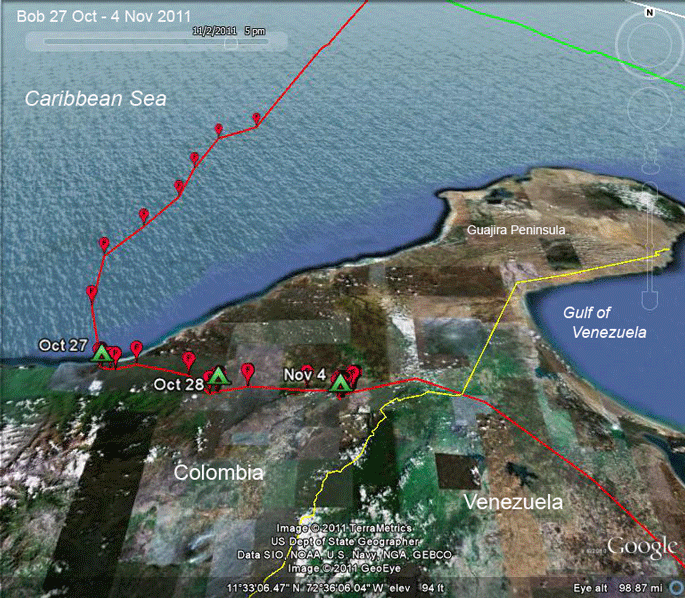 |
28 Oct-4 Nov 2011. Bob rested a bit near the
coast and then moved eastward. On the 29th he
stopped near a large mining operation near
Albania, where he stayed until Nov 5. We were nervous at this point, as there is a lot of human activity there, so we were glad to see him move on, dodging bullets again, both figuratively and perhaps literally. |
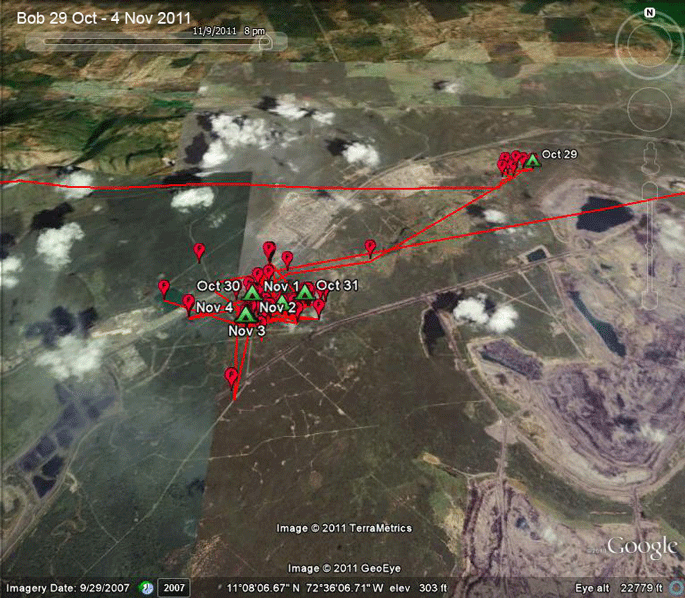 |
28 Oct-4 Nov 2011. Bob a week around this large quarry operation in eastern Colombia. I don't know if the ponds are fish farms, but they look like it, and we were plenty nervous. |
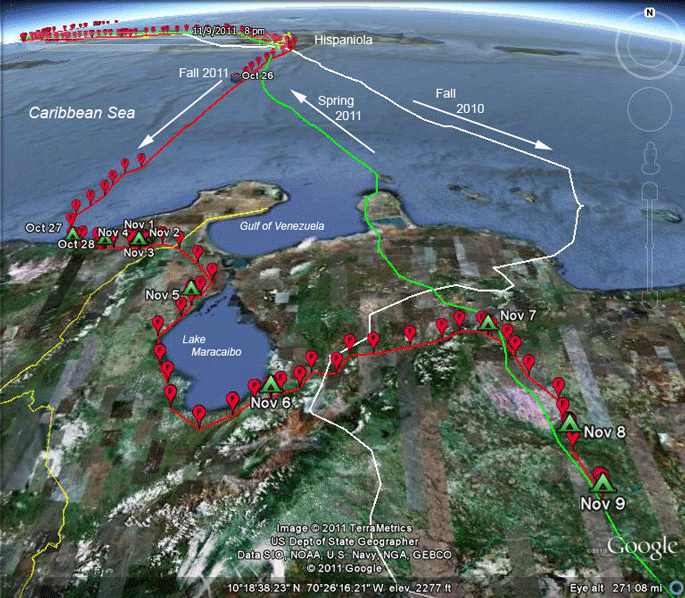 |
26 Oct-9 Nov 2011. Bob landed in South America 340 miles (548 km) west of his landfall in the fall of 2010 and immediately began working his way back to his wintering area in the highlands of southern Venezuela. |
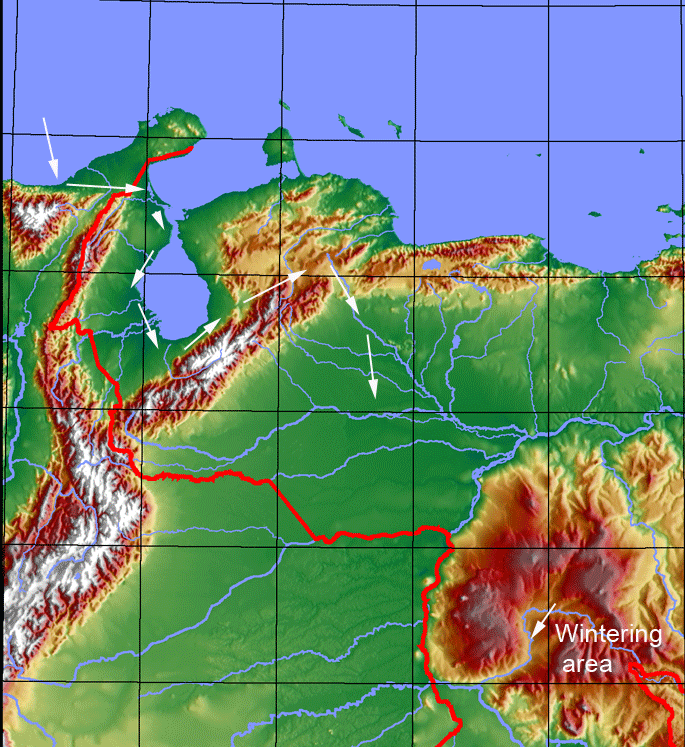 |
28 Oct-7 Nov 2011. In this map it's easier
to see the topography that Bob is working
around. He hit the Colombian coast just north of
the Sierra Nevada de Santa Marta, the world's
highest coastal mountain range, with peaks up to
nearly 18,000 ft ASL (5,700 m). Too much work to
go over that, so Bob worked due east at the foot
of the range and then got into the Lake
Maracaibo Basin. Once into Venezuela, he worked
his way around Lake Maracaibo and then found the
Cordillera de Merida in his way. He skirted the
foot of this range until finding a pass just
south of Barquisimeto. Once through the pass, he was out in the Orinoco River drainage, heading south towards his wintering spot on the Ventuari River in the western reaches of the Guianan Shield. |
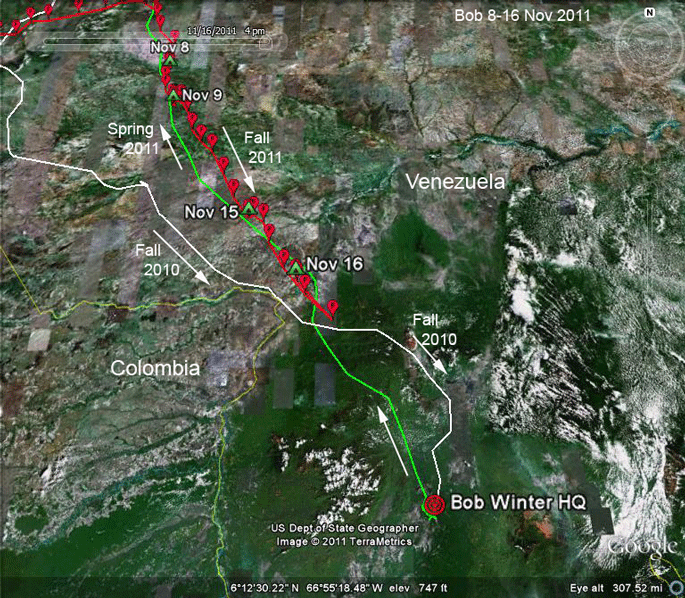 |
8-16 Nov 2011. Bob moved southeast and got to the foothills of the Guianan Shield on the 16th. He moved upslope a bit and then retreated. I suspect he ran into some bad weather at the higher elevation. |
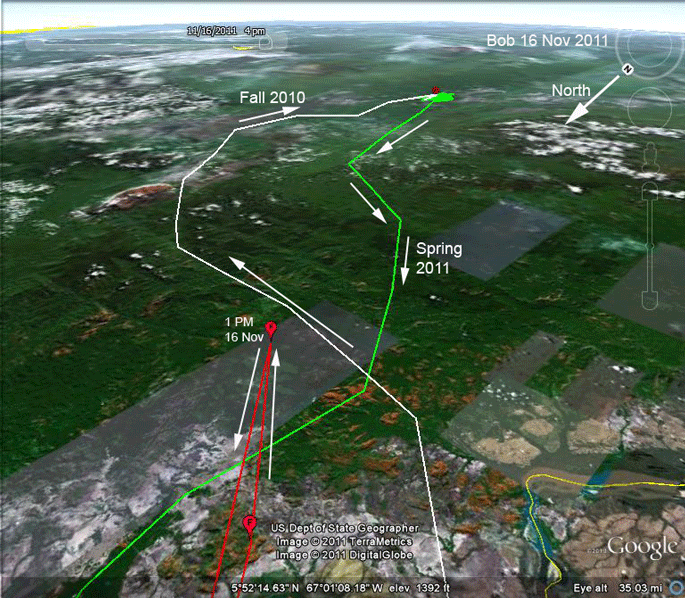 |
16 Nov 2011. Bob followed different valleys going to his wintering area last fall and heading north in the spring. This year on his first attempt he didn't make it into the highlands. He probably ran into bad weather up at higher elevation and then retreated. |
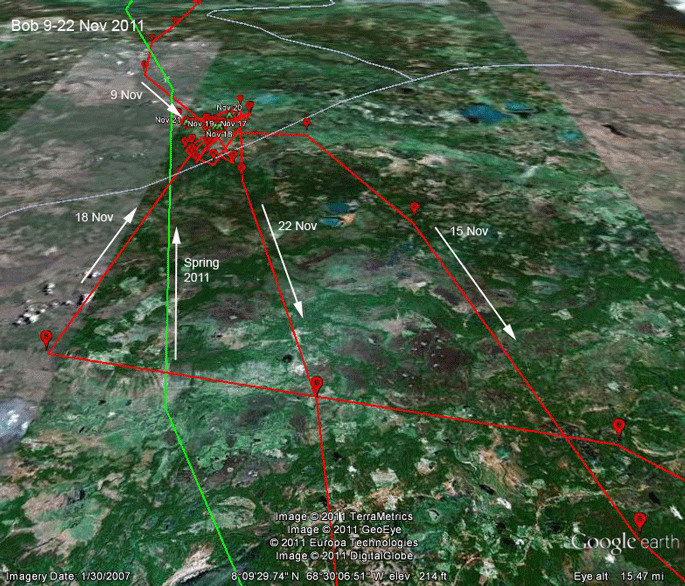 |
17-22 Nov 2011. After abandoning the trip up into the highlands on the 16th, Bob retreated 193 miles (310 km) to a spot where he spent the second week of November. |
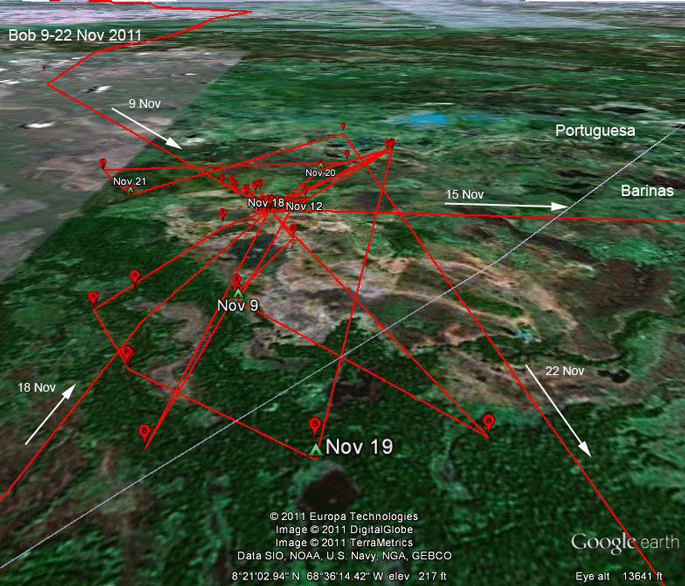 |
9-22 Nov 2011. Here's a more close-up look
at his movement after the aborted trip up the
Guianan Shield. Bob spent 4 days mostly in the
Venezuelan state of Portuguesa. It's hard to say
if the three forays south were real attempts to
get back to his winter home or just fishing
expeditions. The resolution of the imagery here isn't very good, so it's hard to tell what the human activity here is, but it might be some kind of mining. In any case, on the 22nd, he moved south and four days later was back on his winter waters up in the highlands. |
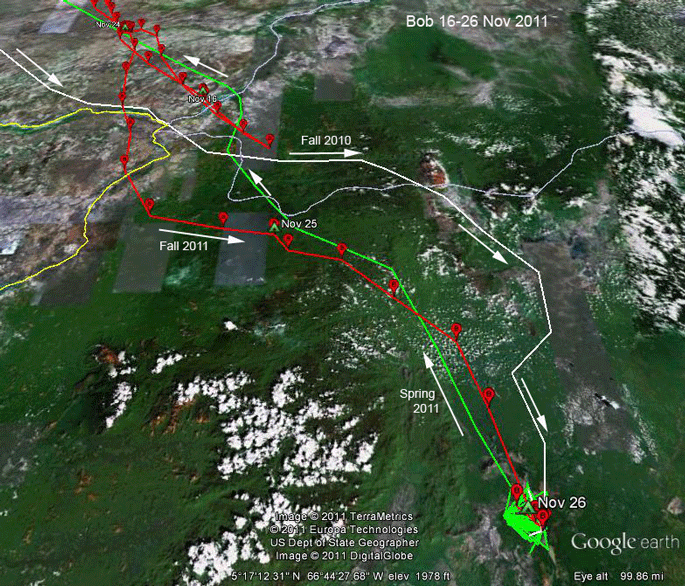 |
22-26 Nov 2011. Home at last! The solid green area is his entire range for last winter. This is one of the reason's adults have a higher survival rate than juveniles--the old birds stay put in a place that has proven to be safe over previous years, while the young birds are wandering around the countryside looking for a really reliable spot. All that movement means an increased chance of running into danger, which nowadays is pretty much synonymous with humans. |
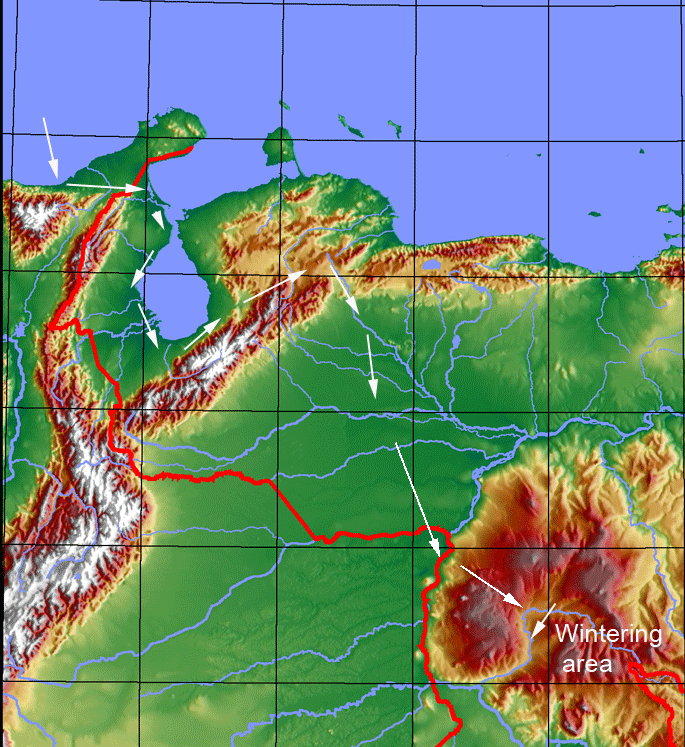 |
27 Oct-26 Nov 2011. Here's how Bob worked
his way around the mountains of northern South
America. In about 4 months, he should turn around and do it again! But wait,.... |
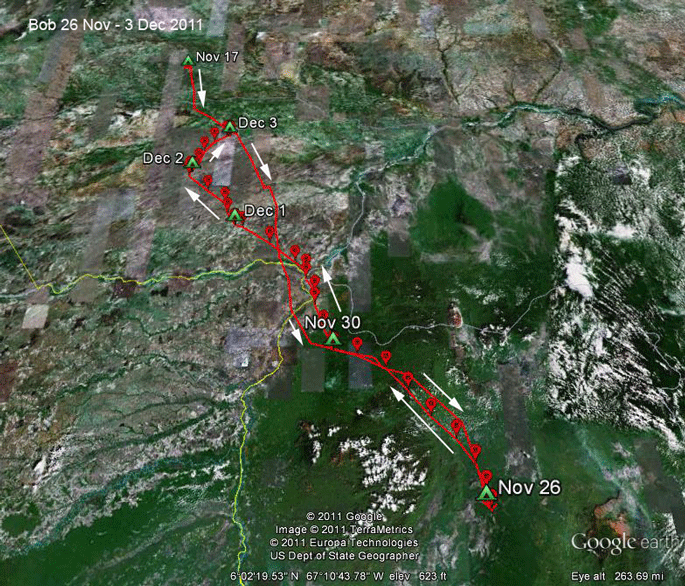 |
26 Nov-3 Dec 2011. Just when I thought I
could stop making maps for a while, Bob throws
us a curve ball and moves back down out of the
highlands. This is really unusual. Every adult except one that we have followed has returned to their winter waters and stayed put until it was time to head north. So, why would Bob have returned to the spot where he spent 5 months last year and after only 4 days head back down out of the highlands? What changed? Hard to imagine the fishing being that different. Has there been increased human activity in the area? We can't tell from the Google Earth images, as they are old. Maybe another Osprey moved in and has claimed the territory? There isn't much evidence that Ospreys are territorial in the wintering areas, so that's a unlikely explanation, but it is a possibility. Stay tuned! |
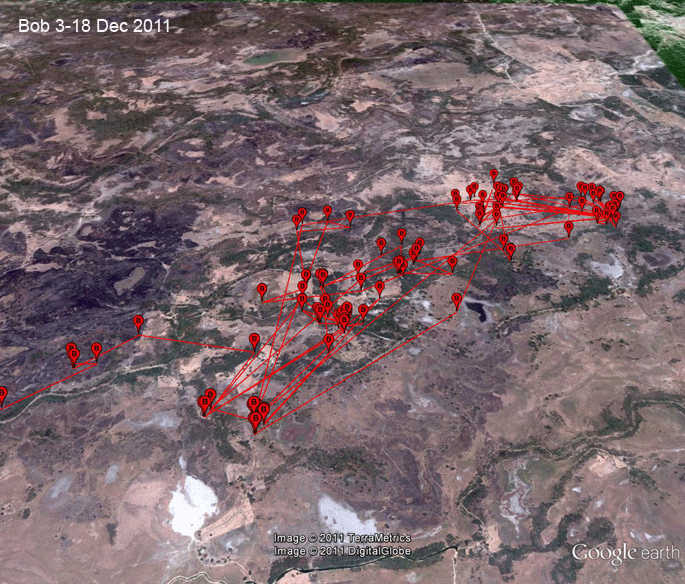 |
3-18 Dec 2011. Here's the area where Bob has
settled down after retreating from his highlands
wintering area. This seems like an unusually dry area for a wintering Osprey, but in fact he's in the seasonally flooded llanos, so much of what we see here is underwater. |
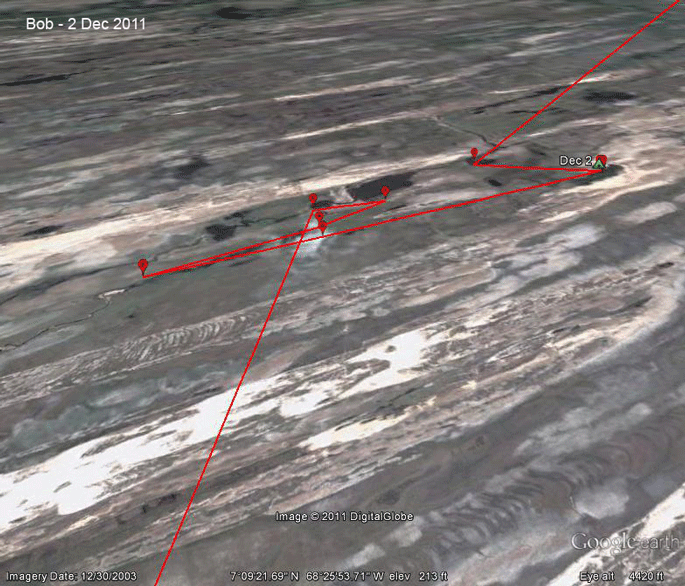 |
2 Dec 2011. Backtracking a bit, Bob spent a day in the strange
dune crossed region of the state of Apure. These
dunes are thought to be caused by the Trade
Winds picking up sand from the Orinoco at low
water. From Wikipedia: A large part of the state of Apure is constituted by an extensive field of dunes (occupying some 30,000 km²), which has the peculiarity of not being a desert climate but a savannah, with natural grasslands alternating with corridors of jungle and voluminous rivers with sand dunes of more than 100 km in length and 20 m in height. |
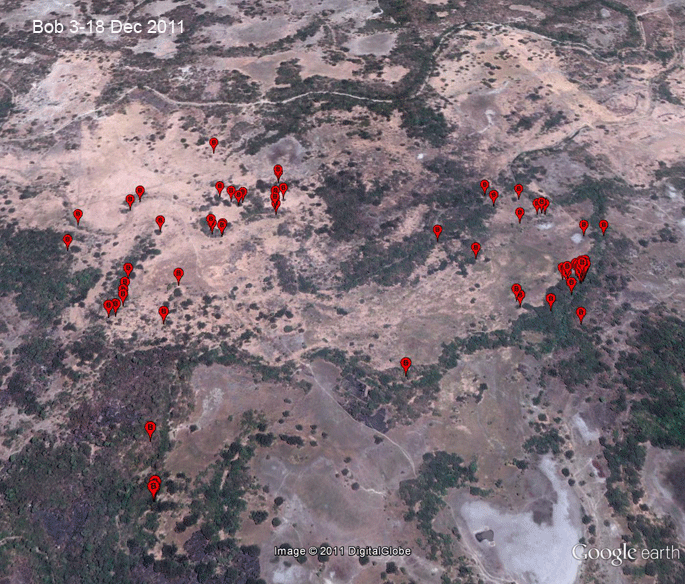 |
3-18 Dec 2011. Bob has settled down in what
appears to be a remarkably inhospitable habitat
for an Osprey. It seems to be a cattle ranching
region with very little obvious water. I'm sending out inquiries to our Venezuelan colleagues to see if they can offer any insights. Maybe this area has much more water now than it did when the satellite imagery was captured. Stay tuned! |
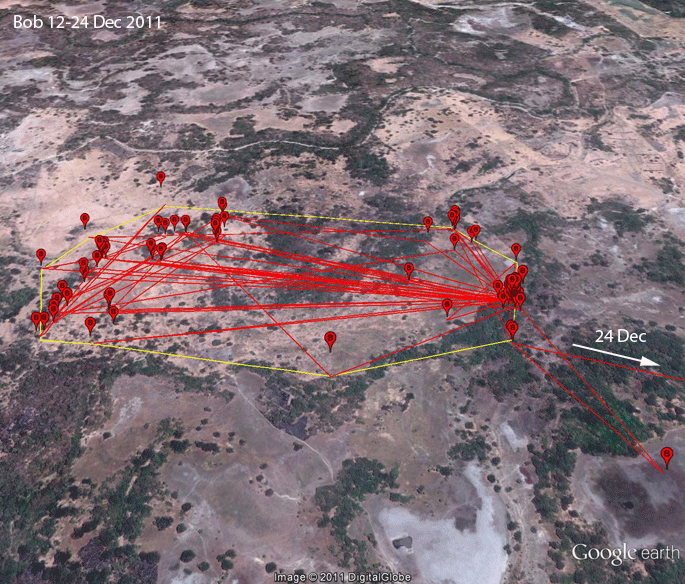 |
12-24 Dec 2011. Another week in the llanos (which were flooded during this time). The area he covered was 0.69 square miles (1.8 square km). On the 24th he decided it was time to get back up into the highlands where he spent all last winter. |
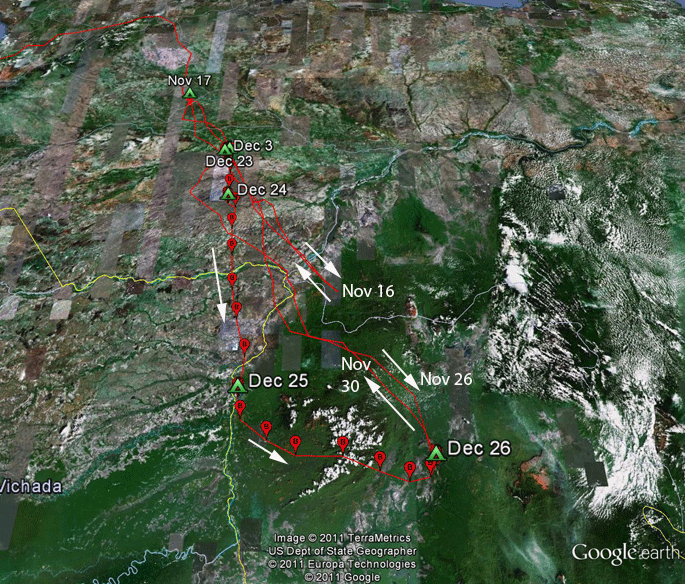 |
24-28 Dec 2011. Bob is back in the
highlands. We can only speculate about why he
got to his winter spot on 26 November and then
turned around 4 days later and retreated to the
llanos. Maybe he left his wallet down there?
After three and a half weeks down in the lowlands, he abandoned the area in favor of his old, reliable fishing waters. |